Soda, Pop, Soft Drinks and other Non-Alcoholic Beverages
Three Strange Florida Oranges Commercials
Sportswriter is composing his column in locker room, communicates directly with distant housewife.Advertising icon is implicitly happy with having her head sliced open and its juice extracted.
Were Western Union workers really given OJ breaks?
Posted By: Paul - Thu Aug 22, 2024 -
Comments (2)
Category: Anthropomorphism, Advertising, Soda, Pop, Soft Drinks and other Non-Alcoholic Beverages, 1950s, 1960s
Pop-Topping
Back in the old days, cans were opened by pulling on an aluminum ring, or "pop top," that would come completely off the can. Now these have been replaced by stay-tabs.Most people threw away the pop-tops, but a few turned them into wearable art. The leader of this movement was Gonzalo Chavez, aka Pop-Top Terp. From Time magazine (Sep 21, 1970):
The first pop-top garments were almost as stiff as their medieval counterparts. But Chavez has made them much more supple. "They fit like a second skin," he claims. "As you wear them, they change shape a little and mold themselves to the contours of the body." Rings differ too. Budweiser's rings are light and flexible, Miller High Life's are "soft," and Pepsi's provide a heavier, stiffer garment.
In 1975, Pop-Top Terp published a book, Pop-Topping, that gave detailed instructions on how to make your own pop-top clothes. But since pop tops have now vanished, it's become a guide to a lost form of art. You can read it online at archive.org.





Posted By: Alex - Tue Jun 18, 2024 -
Comments (2)
Category: Fashion, Soda, Pop, Soft Drinks and other Non-Alcoholic Beverages, 1970s
Bushells Tea: The City of Tomorrow
Posted By: Paul - Sat Apr 13, 2024 -
Comments (0)
Category: Predictions, Yesterday’s Tomorrows, Soda, Pop, Soft Drinks and other Non-Alcoholic Beverages, 1940s, Australia
AI-created soda
Companies are scrambling to get on the AI bandwagon. The latest example of this is Coca-Cola, which recently released Y3000, a soda "co-created with artificial intelligence." The packaging describes it as "futuristic flavored." One reviewer said it tasted like "melted gummy bears with orange." I think I'll pass.More info: CNN Business
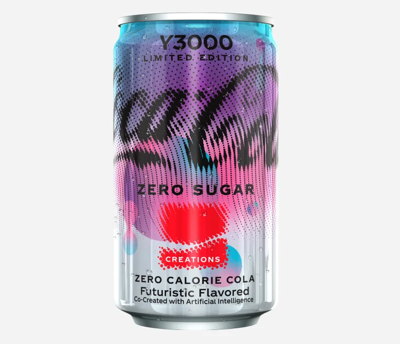
Posted By: Alex - Tue Sep 19, 2023 -
Comments (1)
Category: AI, Robots and Other Automatons, Soda, Pop, Soft Drinks and other Non-Alcoholic Beverages
Soda Pop & the One-Way Bottles
Man, I crashed at the Soda Pop's pad back in '67!
Posted By: Paul - Tue Jun 20, 2023 -
Comments (0)
Category: Advertising, Soda, Pop, Soft Drinks and other Non-Alcoholic Beverages, Bohemians, Beatniks, Hippies and Slackers, 1960s
Win A Diamond Doorknob
Dr. Pepper celebrated its 75th anniversary in 1960, and in honor of this ran a contest with the unusual prize of a diamond doorknob. Specifically: "a doorknob of special design encrusted with 50 small diamonds and a huge two-carat, blue-white diamond mounted in its center. As the grand award the diamond doorknob will be attached to a $25,000 Swift Home having a family-size Refinite-Shedon swimming pool in its backyard and a new Rambler station wagon in its driveway."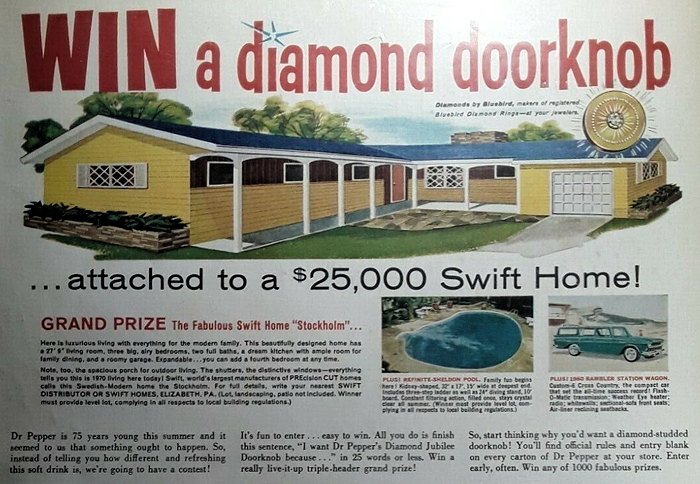
Edith Dillion of Roanoke, VA eventually won the prize. Reportedly she sold the house but kept the doorknob. And perhaps the doorknob is still owned by the Dillion family.
Posted By: Alex - Sat Feb 04, 2023 -
Comments (2)
Category: Awards, Prizes, Competitions and Contests, Soda, Pop, Soft Drinks and other Non-Alcoholic Beverages, 1960s
Sodaburst Premade Ice Cream Soda
So much easier than 1) pouring a glass of soda and 2) scooping some ice cream into it. Completely eliminates the dreaded element of decision-making (which ice cream, which soda?).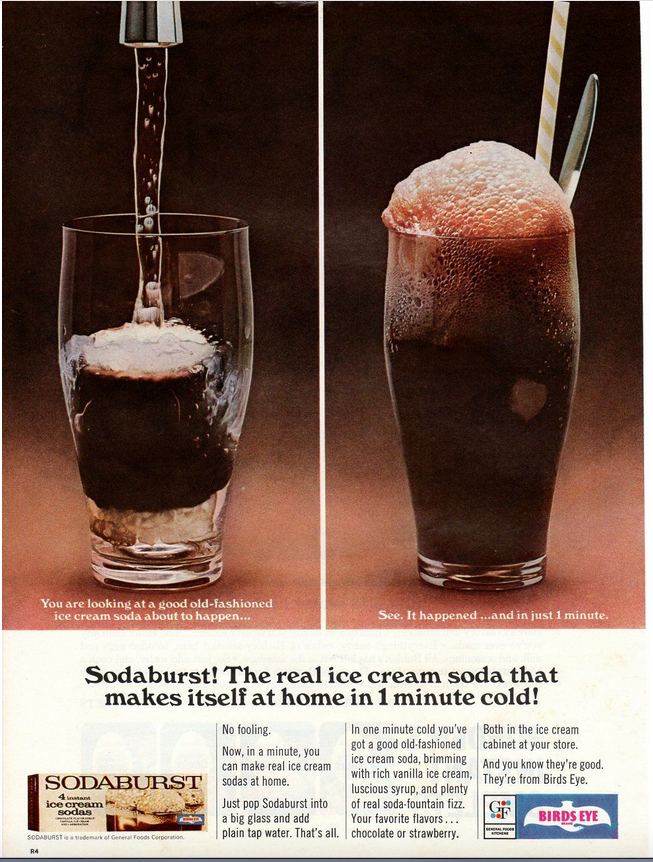
Posted By: Paul - Sun Dec 04, 2022 -
Comments (0)
Category: Food, Soda, Pop, Soft Drinks and other Non-Alcoholic Beverages, Chindogu, 1960s
The NuGrape Twins
The NuGrape Twins were a Georgia blues and gospel duo who recorded in the 1920s. Very little is known about them. Were they really twins? No one knows.What is clear is that they liked NuGrape soda. They only recorded six songs (all for Columbia Records), and two of them were about NuGrape. "I've Got Your Ice-Cold NuGrape" is considered to be their masterpiece. Dylan Kenny, of Yale Daily News, writes, "it’s catchy, it’s weird, it’s an excellent pop song."
Were the NuGrape Twins being paid by NuGrape to sing these songs? Again, no one knows. It seems more likely that they were just big fans of the soda.
I'd never heard of NuGrape soda before, but apparently it's still available. Though it's hard to find outside of the southeast United States.
Posted By: Alex - Mon Oct 24, 2022 -
Comments (1)
Category: Music, Soda, Pop, Soft Drinks and other Non-Alcoholic Beverages, 1920s
Follies of the Madmen #535
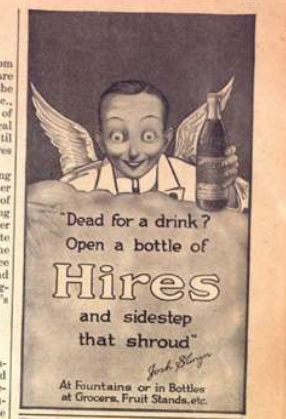
Source. (Page 19)
Posted By: Paul - Tue Jun 14, 2022 -
Comments (3)
Category: Death, Advertising, Soda, Pop, Soft Drinks and other Non-Alcoholic Beverages, 1910s
The replica Roman coin that fooled a museum
Nov 1971: Nine-year-old Fiona Gordon realized that the supposedly ancient Roman coin on display at the South Shields Museum was actually a promotional replica given away by a soft drinks company, Robinsons.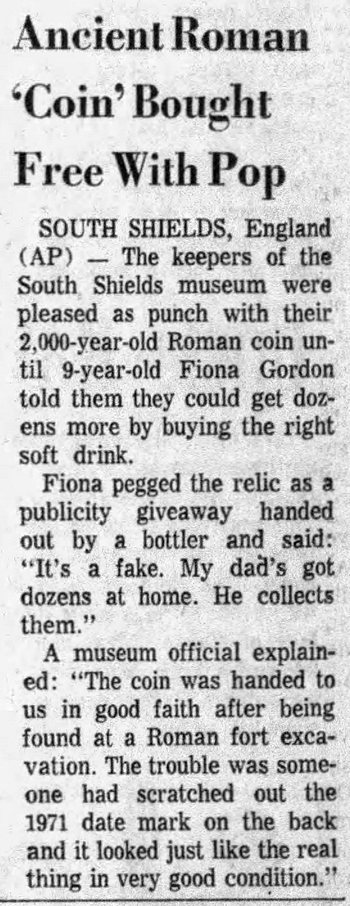
Newport News Daily Press - Nov 3, 1971
I'm pretty sure that the coin below is similar (if not identical) to the one that was on display at the museum. In 1971, Robinsons sent these coins to anyone who mailed in enough bottle caps. (Source: CoinCommunity.com)
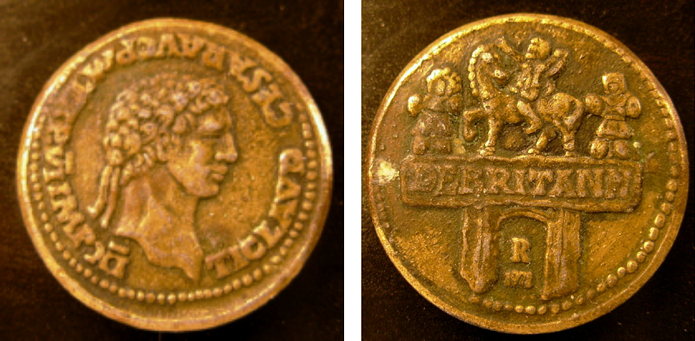
Posted By: Alex - Tue Feb 22, 2022 -
Comments (1)
Category: Imitations, Forgeries, Rip-offs and Faux, Money, Soda, Pop, Soft Drinks and other Non-Alcoholic Beverages, 1970s, Ancient Times

| Who We Are |
|---|
| Alex Boese Alex is the creator and curator of the Museum of Hoaxes. He's also the author of various weird, non-fiction, science-themed books such as Elephants on Acid and Psychedelic Apes. Paul Di Filippo Paul has been paid to put weird ideas into fictional form for over thirty years, in his career as a noted science fiction writer. He has recently begun blogging on many curious topics with three fellow writers at The Inferior 4+1. Contact Us |




